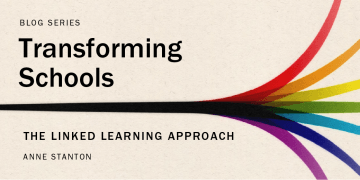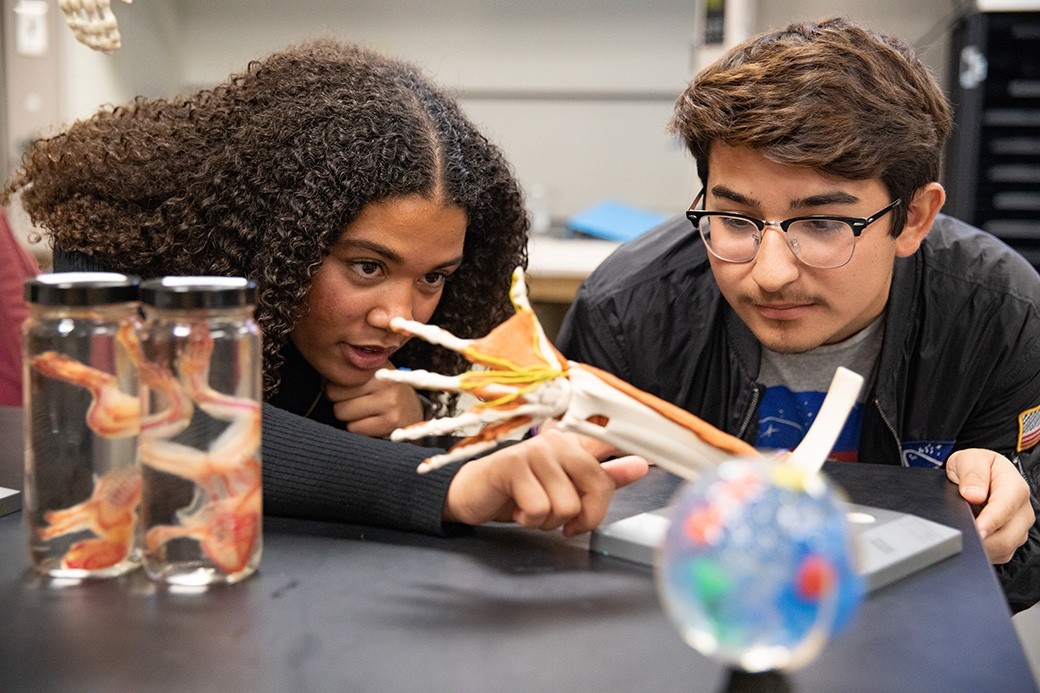Thriving, Learning, and Leading: What Adolescents Are Teaching Us Post-Pandemic and Why We Should Listen

This blog is part of the Transforming Schools series, which shares effective practices and foundational research for educators, students, families, and policymakers who are reimagining schools as places where students are safe and can thrive academically, socially, and emotionally.
While some of the hardships of the pandemic have begun to subside, we know that students—particularly adolescents—are still reeling from its traumas during an extremely formative time in their lives. The Centers for Disease Control and Prevention's latest Youth Risk Behavior Survey shows persistent sadness and hopelessness among U.S. adolescents. In California, student trauma and mental health concerns stemming from the pandemic have contributed to a rise in chronic absenteeism, estimated to be as high as 30% for high schoolers, and a decline in postsecondary enrollment as a wave of young people disconnects from education.
Although students across the nation suffered steep learning loss, disengagement, and burnout, members of some school communities came out of the pandemic thriving. In these schools, students experienced little learning loss, wraparound services remained in place to provide meals and health services, and students remained active, engaged participants in their own learning.
Among those who weathered the pandemic better than most were students and educators in schools using the Linked Learning approach. Designed to personalize learning and address the whole child in keeping with positive youth development principles, schools powered by this approach deliver a powerful mix of supports—from rigorous academics to real-world work experiences to holistic student supports—all integrated into a coherent learning experience that prepares students for college and career.

As part of the Linked Learning approach, educators create learning conditions in which students learn to recognize their emotions and those of others, while also developing self-regulation skills. Positive developmental relationships within schools are supported through structures such as advisory systems, which provide a family group for every student, ensuring they are seen and known by a teacher advocate in their pathway. Young people are also supported to expand their learning and their experiences through apprenticeships, internships, and job shadowing with community partners. Such environments create positive relationships with caring adults, support healthy brain development, and provide opportunities to participate in rigorous and meaningful learning within and outside of the classroom.
These provisions ensure that students are known and supported by many caring adults within and outside of the classroom. Such experiences and the sense of belonging they impart are particularly game-changing for students who are academically behind, are English learners, or are living in poverty. It’s no surprise these support systems also proved critical as schools pivoted to address students’ fundamental human needs in addition to their academic growth during the pandemic.
Carolina Lopez, a recent graduate from the Media and Communication Linked Learning pathway at Jordan High School in Long Beach Unified School District, painted a picture of what truly being seen at school feels like from a student perspective:
Our teachers are always working together to support us. If one of us has any passion project or any ideas, they’re always super excited for us, and our teachers are always recommending us for different opportunities. They provide us with a variety of experiences based on our interests and aspirations so we can try lots of different things while in high school. Plus, they’re always there to support us emotionally with school, and anything. They’re truly great teachers.
Does it make a difference? Yes. In Linked Learning, we have over a decade of evidence that validates bringing schools and communities together in these ways. Students pursue a pathway of study with integrated, college-prep coursework and work-based learning tied to a high-growth industry in their community. Pathways are cohort-based learning communities that link educators and students across subjects and disciplines to better coordinate academic and student support services and ensure that every young person is known and seen.
Dimitrios Chronopoulos is an educator at San Bernardino City Unified School District’s Arroyo Valley High School, which houses six Linked Learning pathways, including the Gold-certified Business and Logistics Academy; Digital Media Academy; and CORE Academy, an energy, environment, and utility pathway providing green technology training. Chronopolous attributes the school’s success to these high-quality pathways:
The core of our success is our intentionality around linking our core academic courses to our [career and technical education (CTE)] courses. A student goes to their math and social studies classes and their CTE course knowing that everything they are learning is connected and tied to possibilities for both college and career. The students know that their English, social studies, and CTE teachers talk daily and plan together. It creates an environment where young people are not only making the academic connection between all three but also making that student support connection.
Students in San Bernardino City Unified feel the impacts of blending rigorous academics and hands-on learning opportunities in beneficial ways. As described by David Paniagua, an alumnus of the Growing Hope Project Linked Learning pathway at San Andreas High School in San Bernardino City Unified:
My teachers are more than just teachers. They’re like family. When I was a student, I remember being asked to share how I felt about this school. And I said, “I feel like I’m living in a dream.” And that’s because I had so many people who were there and supported me and supported my dreams, supported my skills, supported what I love doing. And they wanted to help me improve and learn more about my skills and learn more about what I love to do. And that’s what it’s all about. It’s about love, support, caring, and making relationships.
Often adolescence is seen as a time to endure rather than as a time to embrace—a period of rich personal growth, self-discovery, and potential. Successful school communities view adolescents as valuable assets who can make active, positive contributions to their community—and give these young people the support, agency, and opportunities to do so while building skills and confidence. Education pathways that intentionally connect classroom learning to local business and civic life encourage students to discover their power and make a difference outside of the school walls and in their community well before they enter college or the workforce.
Esther Dabagyan, former principal at the STEM Academy of Hollywood High School and current Career Technical Education and Linked Learning Administrator in the Los Angeles Unified School District, described it like this:
Without a doubt, the personalized nature of our school helped us sustain high levels of student success and academic achievement despite the pandemic. In large part due to the Linked Learning approach and its emphasis on integrating support structures that address students’ academic, social-emotional, mental, and physical well-being, we were able to leverage our strong relationships with community-based organizations, staff, students, employers, and families to make lemonade out of lemons in a time of crisis. Whether we were providing meals or addressing student mental health issues, our deep relationships within our school and outside of it with the broader community, along with our focus on providing both academic, career readiness, and social-emotional support, helped us ensure students thrived and, most importantly, that they felt safe and secure despite the tremendous uncertainty caused by the pandemic.
Students in learning environments that prioritize their well-being and sense of belonging are aware of the support surrounding them every step of the way as they progress academically, socially, and emotionally. Educators also benefit from Linked Learning’s collaborative professional settings. Working within small learning communities, they can develop advisory systems that create small family units within schools, teaching in teams that share students and work toward common goals, and provide rich and relevant experiential learning both in and outside the classroom. In turn, they can advance high-quality teaching and leverage a broader range of wraparound supports for their students.
Kerin Coffey, the Biomedical Science Linked Learning Pathway coordinator at Eastside High School in Antelope Valley Union High School District, put it this way:
During the pandemic, we were able to capitalize on the relationships we had built with our students prior to the shutdown to keep everyone connected. We combined our office hours by grade level and offered extra support to our students to help keep them engaged. The students were used to us working together prior to the shutdown, so they were able to make the transition more smoothly as a result. We also realized during the pandemic how the structures set forth by the Linked Learning approach helped our teachers to remain connected when many other staff members felt isolated. We hear that many schools felt like there was a backsliding of progress during the pandemic, but we attribute the growth we were able to make to the Linked Learning tenets.
Shecid Cruz, a 2023 graduate of the Los Angeles High School of the Arts, a Linked Learning pathway in the Los Angeles Unified School District, described how such positive developmental relationships impacted her high school experience:
Our teachers work with you, and that provides a supportive connection because sometimes we just need somebody to hear us out. And that’s also what our counselor does, as well. She hears us out too, and they really care about you. It wasn’t like that in other schools I attended. At other schools, I felt like they didn’t really care. And when I came to Los Angeles High School of the Arts that changed completely. I know it’s a sad thing to say, but I was like, “You guys actually care?” It’s about sharing a lot of love, support, and appreciation for students and our interests and talents. It’s a connection they build with everyone. And since it is a small school, and it is a small community, all the students and teachers really get to know each other.
Likewise, students at the Huntington Park Institute of Applied Medicine at Linda Esperanza Marquez High School in Los Angeles Unified School District study the health impacts of environmental factors such as those created by a local battery plant. They test air, water, and soil samples; conduct research; and share their findings with their community—including in presentations to the city council.
As adolescents exercise their talents in these ways, they discover who they are, who they want to be, how they want to live, and what they want to do in and for the community. In turn, we discover their power. Set against a harsh pandemic backdrop, this future-focused sense of self becomes even more stabilizing, valuable, and motivating—and, for those around them, it becomes a source of huge inspiration.
Cultivating Connections That Adolescent Minds Seek and Need
Young people form their identities, aspirations, and sense of purpose during adolescence. It’s a time when their brains change in ways they haven’t since early childhood, making increasingly hardwired connections important to their ability to engage in deeper relationships, more complex thinking, and self-reflection. As they grow, adolescents are also seeking meaning within their peer group and the wider world. They crave enriching social connections, as well as outlets for their creative and intellectual passions. Above all, they want to feel seen, heard, and cared for and valued.
This developmental reality calls for the types of educational environments that Linked Learning provides—settings that allow students in this age group to experience learning inside and outside of school—in communities, on college campuses, and in the workplace; surrounded by structures and adults dedicated to their growth. The time is now to make it happen for all our students and the future we all share.
